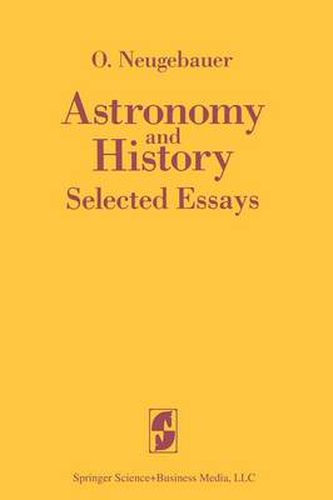Readings Newsletter
Become a Readings Member to make your shopping experience even easier.
Sign in or sign up for free!
You’re not far away from qualifying for FREE standard shipping within Australia
You’ve qualified for FREE standard shipping within Australia
The cart is loading…






This title is printed to order. This book may have been self-published. If so, we cannot guarantee the quality of the content. In the main most books will have gone through the editing process however some may not. We therefore suggest that you be aware of this before ordering this book. If in doubt check either the author or publisher’s details as we are unable to accept any returns unless they are faulty. Please contact us if you have any questions.
The collection of papers assembled here on a variety of topics in ancient and medieval astronomy was originally suggested by Noel Swerdlow of the University of Chicago. He was also instrumental in making a selection* which would, in general, be on the same level as my book The Exact Sciences in Antiquity. It may also provide a general background for my more technical History of Ancient Mathematical Astronomy and for my edition of Astronomi cal Cuneiform Texts. Several of these republished articles were written because I wanted to put to rest well-entrenched historical myths which could not withstand close scrutiny of the sources. Examples are the supposed astronomical origin of the Egyptian calendar (see [9]), the discovery of precession by the Babylonians [16], and the simplification of the Ptolemaic system in Copernicus’ De Revolutionibus [40]. In all of my work I have striven to present as accurately as I could what the original sources reveal (which is often very different from the received view). Thus, in [32] discussion of the technical terminology illuminates the meaning of an ancient passage which has been frequently misused to support modern theories about ancient heliocentrism; in [33] an almost isolated instance reveals how Greek world-maps really looked; and in [43] the Alexandrian Easter computus, held in awe by many historians, is shown from Ethiopic sources to be based on very simple procedures.
$9.00 standard shipping within Australia
FREE standard shipping within Australia for orders over $100.00
Express & International shipping calculated at checkout
This title is printed to order. This book may have been self-published. If so, we cannot guarantee the quality of the content. In the main most books will have gone through the editing process however some may not. We therefore suggest that you be aware of this before ordering this book. If in doubt check either the author or publisher’s details as we are unable to accept any returns unless they are faulty. Please contact us if you have any questions.
The collection of papers assembled here on a variety of topics in ancient and medieval astronomy was originally suggested by Noel Swerdlow of the University of Chicago. He was also instrumental in making a selection* which would, in general, be on the same level as my book The Exact Sciences in Antiquity. It may also provide a general background for my more technical History of Ancient Mathematical Astronomy and for my edition of Astronomi cal Cuneiform Texts. Several of these republished articles were written because I wanted to put to rest well-entrenched historical myths which could not withstand close scrutiny of the sources. Examples are the supposed astronomical origin of the Egyptian calendar (see [9]), the discovery of precession by the Babylonians [16], and the simplification of the Ptolemaic system in Copernicus’ De Revolutionibus [40]. In all of my work I have striven to present as accurately as I could what the original sources reveal (which is often very different from the received view). Thus, in [32] discussion of the technical terminology illuminates the meaning of an ancient passage which has been frequently misused to support modern theories about ancient heliocentrism; in [33] an almost isolated instance reveals how Greek world-maps really looked; and in [43] the Alexandrian Easter computus, held in awe by many historians, is shown from Ethiopic sources to be based on very simple procedures.